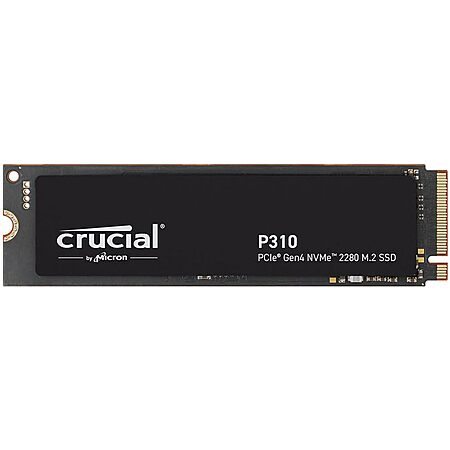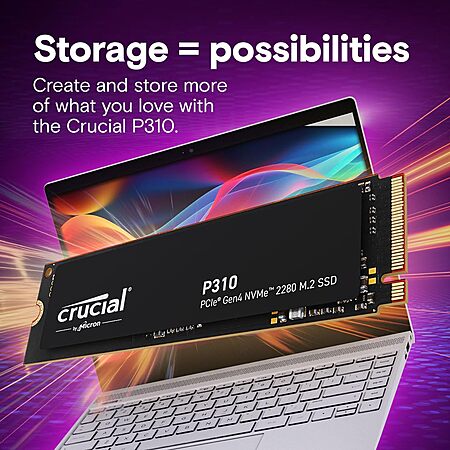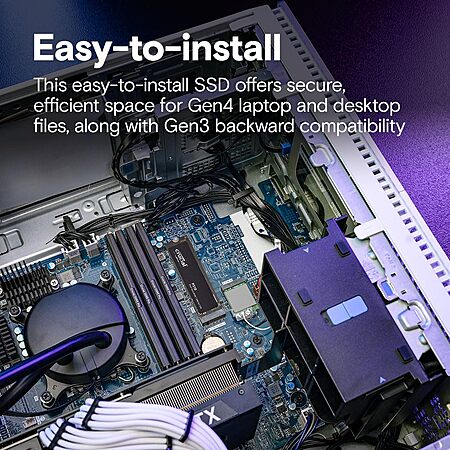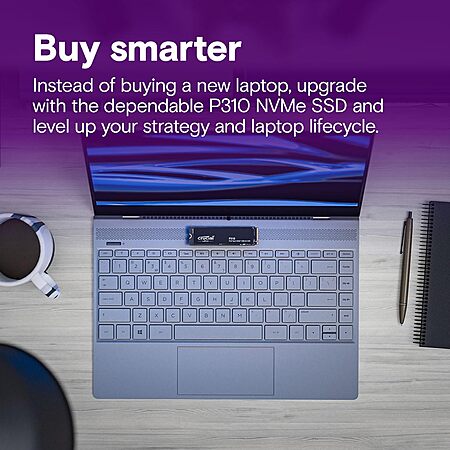https://www.bhphotovide
expireddoublehelixx | Staff posted Mar 03, 2025 03:34 PM
Item 1 of 4
Item 1 of 4
expireddoublehelixx | Staff posted Mar 03, 2025 03:34 PM
1TB Crucial P310 2280 PCIe Gen4 3D NAND NVMe M.2 SSD
+ Free Shipping$65
$98
33% offAmazon
Visit AmazonGood Deal
Bad Deal
Save
Share




Leave a Comment
Top Comments
According to https://www.techpowerup
Just look at what's on the NVME PCB.
Outside of the NAND itself and the controller, the rest is very rudimentary. Most of it is components you'll find on every other circuit in existence.
As long as these companies are sourcing reputable NAND and controllers, that should be what matters most.
The only reason you didn't see more brands with mechanical drives is because the assembly of a mechanical drive is way more technical, requiring clean rooms and special gasses. However, the PCBs were often outsourced to the same types of companies now capable of making NVME drives.
37 Comments
Sign up for a Slickdeals account to remove this ad.
Some think it doesn't matter. I think it does. Previous discussion:
https://slickdeals.net/f/18095737-2tb-msi-spatium-m461-m-2-2280-pcie-4-0-nvme-qlc-solid-state-drive-85-free-shipping?v=1&p=
There's more to it than that. Like chip binning, quality assurance/control...
If anything, companies that produce most of their NAND internally might go through less vetting through no exchange of hands.
And flash quality is variable too. A few old random articles or blogs:
2016
https://www.tomshardwar
https://www.anandtech.c
...
I've never been a big fan of OEM-packaged NAND because OEMs tend to be more tight-lipped about the specifics of the NAND and it's easier to silently switch suppliers
https://www.bunniestudi
http://www.usbtalk.net/2009/09/na...explained/
And flash quality is variable too. A few old random articles or blogs:
2016
https://www.tomshardwar
2014
https://www.anandtech.c
2010
https://www.bunniestudi
2009
http://www.usbtalk.net/2009/09/na...explained/
There's no structure by which the manufacturer of the NVME drive is required to do their own binning. Companies opting to do their own binning are exceptions to the rule.
Regardless, how do you explain away the companies that manufacture their own NAND and still run into detective products? The 990 Pro, for instance?
$30 for 2TB? When? How?
2nd-tier manufacturers seem more likely to be susceptible to getting or using lower-grade flash, potentially on purpose because they want cheaper flash, or because they have less knowledge, or more need to cut corners.
Sure. But I hypothesize that NAND manufacturers who also produce SSDs have better vertical integration. They're the first to get to pick the best chips, they have the most room for price optimization, and they know the most about their raw product.
2nd-tier manufacturers seem more likely to be susceptible to getting or using lower-grade flash, potentially on purpose because they want cheaper flash, or because they have less knowledge, or more need to cut corners.
No one is immune. Yet I'd trust Samsung, Micron, Hynix, over Kingston, AData, and definitely TeamGroup, or newcomers like Orico, or even lesser known brands.
The use of "seems" makes it sound like you believe some of these products are being watered down, maybe by way of some lack of ability.
No manufacturer is producing flash that is deliberately more defective than another, so "quality" is only relative to the class of memory produced.
If a company wants TLC NAND capable of 6000MBps with a TBW of 500TB, it's not going to be any different than when Sandisk comes around and wants the same memory.
It's true that lesser known companies aren't attempting to go toe to toe with Samsung in terms of bandwidth, capacity, or architecture, but that's largely by design. They spec for what they think they can sell.
Sign up for a Slickdeals account to remove this ad.
https://us-store.msi.com/SPATIUM-M461-2TB
People are obsessed with TBW as a sign of quality. But it's at least as much a limit of the manufacturer's warranty risk. The more likely you are to have claims (high TBW or longer warranty period), the more you need to charge to cover the cost of replacements.
It's kind of like how Honda has lower mileage warranties than Hyundai. Honda doesn't need a 100k mile warranty to assure their customers that they make a quality, reliable car. Everybody knows (or is) someone who has had a Honda last a long time with minimal work.
Meanwhile, Hyundai will tell you that when it breaks within 100k miles, they'll fix it free.
https://us-store.msi.com/SPATIUM-M461-2TB
$20 might be a material difference to you, or might otherwise set you back from a more important financial goal.
You're selling your old PC and want to keep that drive, so you replace it with something cheap, even if it is half the space for $20 less. Either drive is probably going to result in the same resale price.
So how come the best practices guides I read tell us to pay attention to the make and model of the NVME drives we use?
And don't you dare say "backup" because restoring a petabyte of data could cost a business a ghastly sum of money.
Sign up for a Slickdeals account to remove this ad.
So how come the best practices guides I read tell us to pay attention to the make and model of the NVME drives we use?
And don't you dare say "backup" because restoring a petabyte of data could cost a business a ghastly sum of money.
It's not like failure ratings are anything new. Hard drives advertise their MTBF and hardly anyone in the consumer world paid attention. It's just that this new crop of tech people are overly sensitive about everything (blame YouTube).
As for businesses, yes, the answer is to make regular backups.
That's why most of them are still using mechanical drives and tape.
If you had a petabyte to worry about, you would know this.
Leave a Comment